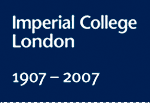Timeline
- 1845 – 1899 |
- 1900 – 1909 |
- 1910 – 1919 |
- 1920 – 1929 |
- 1930 – 1939 |
- 1940 – 1949 |
- 1950 – 1959 |
- 1960 – 1969 |
- 1970 – 1979 |
- 1980 – 1989 |
- 1990 – 1999 |
- 2000 – present
Imperial College 1950 - 1959
World
 1950 - First Organ Transplant
1950 - First Organ Transplant
The first successful organ transplant took place in Boston on 23 December 1954, when Richard Herrick received a kidney from his healthy identical twin brother, Ronald. Richard survived for eight years until the original kidney disease struck again.
back to top
 1951 - Festival of Britain
1951 - Festival of Britain
The Festival of Britain was a national exhibition which opened in London and around Britain in May 1951. At that time, shortly after the end of World War II, much of London was in ruins and redevelopment was badly needed. The Festival was an attempt to give Britons a feeling of recovery and progress and to promote better-quality design in the rebuilding of British towns and cities following the war. The Festival also celebrated the centenary of the 1851 Great Exhibition. It was the brainchild of Gerald Barry and the Labour Deputy Leader Herbert Morrison who described it as "a tonic for the Nation".
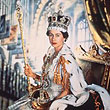 1952 - Elizabeth II becomes Queen
1952 - Elizabeth II becomes Queen
Elizabeth became Queen of the United Kingdom, Canada, Australia, New Zealand, South Africa, Pakistan and Ceylon upon the death of her father, George VI on 6 February 1952.
back to top
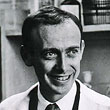 1953 - Watson and Crick publish their discovery of the structure of DNA
1953 - Watson and Crick publish their discovery of the structure of DNA
Scientists James Watson and Francis Crick were the first to describe the structure of a chemical called deoxyribonucleic acid, or DNA, which makes up the genes that pass hereditary characteristics from parent to child. They received the 1962 Nobel Prize for Physiology or Medicine, which they shared with another DNA pioneer, Maurice Wilkins.
 1957 - Soviet Satellite Sputnik Launches Space Age
1957 - Soviet Satellite Sputnik Launches Space Age
Sputnik 1, the first artificial satellite, was launched on October 4, 1957.The world's first artificial satellite was about the size of a basketball, weighed only 183 pounds, and took about 98 minutes to orbit the Earth on its elliptical path.
Sputnik 2 was launched on November 3, 1957 and carried the first living passenger, a dog named Laika.
back to top 1958 - NASA founded
1958 - NASA founded
On July 29, 1958, President Dwight D. Eisenhower signed the National Aeronautics and Space Act of 1958. It formally established the National Aeronautics and Space Administration (NASA) on October 1, 1958, headed by T. Keith Glennan. The agency's official mission was: "To provide for research into problems of flight within and outside the Earth's atmosphere, and for other purposes."
College
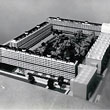 1950 - Inception of expansion scheme was 29th January 1950
1950 - Inception of expansion scheme was 29th January 1950
On 29th January 1950, the government announced in the Commons that it was intended that imperial College should expand to meet the scientific and technological challenges of the 20th century. As a result, the Rector, Sir Roderic Hill, launched the Jubilee Expansion Scheme. Development officers were appointed, who investigated similar overseas and UK institutions. The expansion had to include both technology and science; plans for innovations such as computing were made, General Studies, Management Studies and History for Science and technology were all new subjects to be added to the curriculum. New buildings included a large library and a 1000-seat Great Hall.
Between 1953 and 1963, the government required Imperial College to double in size. Student numbers had to be increased to 3,000 during the quinquennium 1957-1962. The Rectors in office during this period, both Sir Roderick Hill until 1954 and between 1954 to his untimely death in 1966, Sir Patrick Linstead enthusiastically took up the challenge.
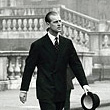 1953 - Private visit to Imperial by Duke of Edinburgh
1953 - Private visit to Imperial by Duke of Edinburgh
Shortly before the coronation of Queen Elizabeth II May 10th Prince Philip visited College privately. Prince Philip has a strong interest in Science and Technology and its application to industry.
back to top
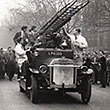 1955 - Jez is donated to the Royal College of Science Motor Club as its mascot
1955 - Jez is donated to the Royal College of Science Motor Club as its mascot
In 1955 the students of the Royal College of Science were looking for a suitable means of transport for their President. On finding that there was a fire engine for sale, the students made an offer of £50 for the vehicle, but the owners, Joseph Crosfield and Son, decided to donate it to the students for its "educational value". They travelled to Warrington to collect it, with their only introduction being a drive round the block, after which they faced a two hundred mile journey with considerable trepidation. The reliability of the fire engine was in serious doubt, and the problems attached to restarting the engine if it stalled, or indeed was deliberately stopped, appeared to be rather overwhelming. The average range for a man when operating the starting handle had been quoted as 25 feet. The brave four set out, and were soon tearing along, but the driver at the time claimed he was not quite sure whether he, or the fire engine, was in control at the time. The name "Jezebel" was eventually chosen due to the vehicle's temperament, which can be summed up by the following quote from a driver at Crosfield's: "when not trying to turn around in a circle, Jezebel had a pronounced tendency to proceed sideways like a crab".
Listen to a 1957 description of Jez.
back to top
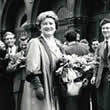 1957 - The Roderic Hill building opened by Queen Elizabeth The Queen Mother
1957 - The Roderic Hill building opened by Queen Elizabeth The Queen Mother
A new building for Aeronautics and Chemical Engineering, named after Sir Roderic Hill, Rector 1948-1954 was opened by Queen Elizabeth the Queen Mother in 1957.
Listen to the opening ceremony of the Roderic Hill building.
back to top 1957 - College's 50th anniversary
1957 - College's 50th anniversary
1957, the 50th anniversary year, saw College far into a great building project to accommodate the modern teaching and research facilities and students that would fulfil the vision for expansion in scientific and technological education. By 1957, the floor space had been increased by 20%.
Estimates for the building work in December 1957 were: 85,000 cubic yards of cement, 3,250 tons of steel reinforcements and 6 million bricks! It was not all plain sailing though as disputes could not be settled as easily as Professor Blackett envisaged by imposing academic solutions.
Also in 1957, work began on the Mechanical Engineering Building, which was being constructed behind the Waterhouse designed City and Guilds Building.
Other 50th birthday celebrations included a 50th birthday dinner held at Mansion House, a ceremony in the new Union Concert Hall and a College Ball.
Listen to a special 50th birthday radio broadcast about Imperial.
back to top 1957 - Exploration Board established
1957 - Exploration Board established
Exploration Board set up to assist students who wish to travel and work on projects, with the first trip to Karakorum.
back to top
 1959 - Biochemistry Department
1959 - Biochemistry Department
In 1959 the Wolfson Foundation gave £350,000 for a new Biochemistry Department, with Sir Ernst Chain as its first Professor.
back to top
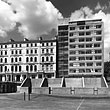 1959 - Weeks Hall is completed and opened
1959 - Weeks Hall is completed and opened
An increase in halls of residence capacity was a necessity and the opportunity to expand residences in Princes Gardens, the square across Exhibition Road, was enthusiastically developed with Sheppard Robson as architects.
Weeks Hall was begun in 1957 due to the generosity of a donation from Vickers the engineering company which benefited from Imperial trained students. Lord Weeks was the Chairman of Vickers Ltd 1945 - 1956 and was instrumental in obtaining funding for the Hall, which was to include a summer conference centre for Vickers.
back to topPeople
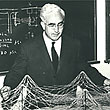 Stanley Robert Sparkes (1910-1976)
Stanley Robert Sparkes (1910-1976)
Sparkes was seconded to take charge of the College Planning Office in 1953, and be Director of Building Works until 1958. A Professor of Structural Engineering in the Civil Engineering Department 1959 -1972, Sparkes was part of the group involved in the Indian Institute of Technology (Delhi) development.
He was Dean of City and Guilds College 1964-1967 and President of the Rugby Football Club.
 Sir Patrick Linstead FRS (1902-1966)
Sir Patrick Linstead FRS (1902-1966)
Sir Patrick Linstead became Rector following the death of Roderic Hill. Linstead was an Organic Chemist whose work included the discovery of phthalocyanine dyes.
back to top
 Helen Kemp Porter (1899-1987)
Helen Kemp Porter (1899-1987)
Helen Porter was appointed to Chair of Plant Physiology in 1959, becoming the first woman professor at Imperial. After joining Imperial in 1921, she spent a year in the Organic Chemistry Department and was then appointed Research Assistant in the Botany Department.
In 1923 she joined the staff of the Research Institute of Plant Physiology attached to the College and concentrated primarily on research in the field of carbohydrate metabolism. She was engaged in research in America after the war. In 1953 with the support of the Nuffield Foundation, the enzymology laboratory was opened within the Plant Physiology section of Imperial, under the direction of Porter. In 1956 she was elected FRS (12th woman to be elected)
back to top Richard Barrer (1910-1996)
Richard Barrer (1910-1996)
Richard Barrer studied at New Zealand before joining to Clare College Cambridge, between 1932 and 1939 where he was awarded a PhD. He was a sportsman, winning the Varsity Cross Country in 1934 and competing in other years. Barrer joined Imperial as Professor of Physical Chemistry in 1954, a position he retained until 1977. He was also Dean of the RCS.
Barrer's interests in zeolites developed during the late 1930s and early 1940s. His work on zeolites was pioneering and his studies led to the industrial development of these materials in the late 1950s and early 1960s. These developments changed the economy of the developed world and the petrochemical industry, as zeolites proved very efficient in the conversion of crude oil to high octane fuels. Zeolites were also relatively clean materials, something that qualifies Barrer as one of the first "green" chemists Barrer also developed methods of measuring permeation rates.
There is the Barrer Award named after Richard Barrer given by the Royal Society of Chemistry and the Society for Chemical Industry in conjunction with the British Zeolite Assoication, every three years by for the best work in the area of porous inorganic chemistry.
back to top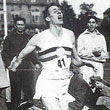 Roger Bannister (1954)
Roger Bannister (1954)
On 6 May 1954 at the Iffley Road running track in Oxford, 24 year old St Mary's Hospital Medical School student Roger Bannister sprinted his way onto the world athletics scene and into the world record books. In a time of 3 minutes, 59.4 seconds, the young athlete ran the first ever sub four minute mile.
Since his student days, Sir Roger has maintained a long-standing connection with St Mary's, and later Imperial College when the two institutions merged. He worked as a consultant neurologist at St Mary's Hospital (and the Western Ophthalmic Hospital) from 1963 to 1985, chairing the St Mary's Hospital Medical Committee over the same period. Since 1984, Sir Roger has also been a trustee of the St Mary's Development Trust, and its Chairman since 1998.
In 2004, the College named a lecture theatre on the St Mary's Campus, part of the St Mary's Redevelopment, after Sir Roger, a fiftieth anniversary tribute to the man who did the impossible - running the 'miracle mile'. At the opening, Sir Roger described the art of record breaking as 'the ability to take more out of yourself than you've got.'
back to top Alec Westley Skempton (1955)
Alec Westley Skempton (1955)
Alec Westley Skempton was a former undergraduate of the Civil Engineering Department. After taking an MSc in Concrete, he worked at the Building Research Station where he began to develop a soil mechanics group, a new science. He was invited to give undergraduate lectures as a visiting lecturer in 1936 and was appointed by Pippard in 1946 to establish the Soil Mechanics Section in the Civil Engineering Department. Post graduate courses began in 1950, but he was not appointed Professor of Soil Mechanics (a new post) until 1955. The post remained vacant on his appointment as Head of Department in 1957 until 1965. Skempton was the Head of Department for Civil Engineering from 1957 - 1976.
The Department expanded under his leadership. Skempton continued to pioneer work on soil mechanics, working on dam and other failures, such as the Aberfan Disaster. He was invited to join a commission on the Leaning Tower of Pisa in 1965. He was part of the Civil Engineering Department team which looked at the stability of the Queen's Tower, completed in 1968. The Civil Engineering Building has recently been renamed the Skempton Building.
For more information on Skempton, visit http://www.cv.ic.ac.uk/SkemArchive/index.htm
back to top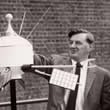 Harry Elliot (1920)
Harry Elliot (1920)
Harry Elliot was educated at Manchester University, graduating in Physics in 1941. He served in the RAF until 1945, returning to Manchester for postgraduate study, becoming Lecturer in Physics after gaining his PhD. He joined Imperial in 1954 as a Lecturer, becoming Senior Lecturer in 1956 and reader in 1957. He was made Professor of Physics in 1960. Elliot was a leading expert on the geophysical and astronomical aspects of cosmic rays.
Imperial College Cosmic Ray and Space Physics Group, was led by Harry Elliot and according to Andre Balough's website first participated in a space mission in 1962. The group built a cosmic ray detector for the first British scientific satellite, Ariel 1.
Elliot took an extensive part in the establishment of the European Space Research Organisation (ESRO) in 1964 and the Cosmic Ray Group built three scientific instruments for ESRO's first satellite, ESRO II, launched in 1967. These instruments measured cosmic rays and other energetic particles in near-Earth space. The group contributed 23 instruments to the HEOS-1 (launched in December 1968), the first European spacecraft to venture outside the Earth's magnetosphere. One instrument measured cosmic rays, one measured energetic particles, and one measured magnetic fields in space.
The Imperial College team involved in that mission was led by Prof. Elliot, and consisted of Bob Hynds Andrew Engel, Peter Hedgecock and André Balogh. The magnetometer on that spacecraft started a long involvement by the group in the measurement of magnetic fields in space.
In 1972, D.J Southwood a former Imperial student wrote that there was a large involvement in the British Ariel programme and the new ESRO (European Space Research Organisation) programme - the joke was that the initials HEOS for the ESRO spacecraft launched in 1972 stood for 'Harry Elliot's Own Satellite'
back to top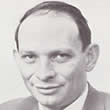 Professor Samuel Eilon (1923)
Professor Samuel Eilon (1923)
Professor Eilon came to Imperial in 1952 as a postgraduate student, having been educated in the Israel Institute of technology in Haifa and working in industry. He gained his PhD in 1955 and became Lecturer in Production Engineering. In 1957 he returned to Haifa as Associate Professor and instituted a postgraduate course in production engineering, returning to Imperial as reader in 1959.
He won two Whitworth prizes for papers published by the Institution of Mechanical Engineers in 1960. In 1963 he was awarded a DSc (eng) and became Professor of Production Engineering in 1964.
His main research interest lay in the areas of production and inventory control, behavioural models of decision processes and industrial applications of operational research. He played an active role in the Institution of Production Engineers and councils for Management Education and in 1976, was a founding member of the Fellowship of Engineering (the Academy of Engineering)
back to top© 2007 Imperial College London
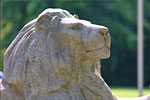
Through the first decade of the twenty-first century the campaign seeks to philanthropically raise £207 million from Imperial’s alumni, staff and friends, and donations from charitable foundations and industry.
Where your support can make a differenceGive now
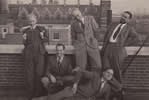
We’re celebrating 100 years of living science with 100 stories. We’ve collected some of them already, and invite you to share your own stories and memories.
